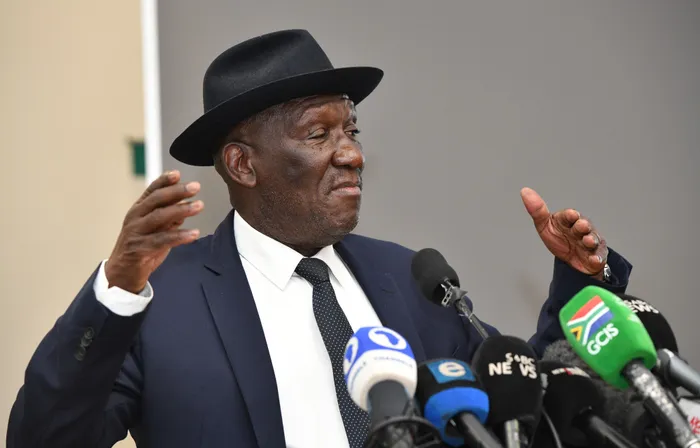What can be done to reduce the crime rate?

Picture: Kopano Tlape – Minister of Police General Bheki Cele presents the quarterly crime statistics for the first quarter of the 2022/2023 financial year – from April 1, 2022, to the end of June 2022. It has been reported that Cele has hinted that South Africans should brace for more shocking crime statistics, the writer says.
By Zelna Jansen
The National Crime Prevention Strategy (NCPS) says that South Africa’s violent history has embedded a “culture of violence”. This contributes to the elevated levels of violence associated with criminal activity.
Studies show that because of socio economic factors, many people have an ambivalence towards the law, and punitive measures aimed to prevent crime have lost their sting.
It is therefore not surprising that the murder rate has increased by 11.5 percent in the first quarter of 2022 as compared to the same period for 2021. Among others, attempted murder rose by 8.4 percent and carjacking by 14 percent.
Rape decreased by 4.9 percent, sexual assault decreased by 10.2 percent and the total sexual offences decreased by 6.7 percent.
It has been reported that Minister Bheki Cele, hinted that South Africans should brace for more shocking crime statistics. Why so? One of the reasons could be the reduction in the budget allocated to the South African Police Services (SAPS). Budget cuts are due to government’s cost cutting measures after the Covid-19 pandemic resulted in deficits in revenues and economic growth.
Notwithstanding the latter, SAPS has been criticised for underspending its budget by R4 billion. This is unfortunate as R4 billion could have gone a long way in employing police officials and capacitating community police stations.
The Police and Prisons Civil Rights Union (Popcru) has said the imposed austerity-type measures will slow down the already weakened services offered by SAPS. It also says that the budget reductions will inevitably affect the conditions of service and worsen the state of the uneven allocation of resources.
South African communities do not need more demoralised police officials serving them, as demoralised police officials may find it easier to participate in corrupt activities or turn a blind eye to crime and corrupt activities. The police to citizen ratio is high. It presently stands at one police officer to every 220 citizens.
Better off communities will employ security services. The cost of budget cuts is therefore shifted to the public, and poorer communities will be left to the mercy of violent and unscrupulous criminals.
In the long term, the NCPS implements various programmes that address the root causes of crime. Ideally, in the short term, more police could assist in curbing crime.
This brings one to the question, in the present budget constraints, how can SAPS employ more police officers, detectives, forensic experts to boost the fight against crime? How can funds be obtained to fix the 4,398 out-of-service police vehicles and resource community police stations?
Restructuring the budget could be a good place to start. SAPS has recognised that it is top heavy. Other than the national and provincial commissioners, the police structure further consists of about two 200 generals and more than 600 brigadiers collectively earning around R1 billion annually. Each general has a driver with two protectors and a luxury vehicle. They have the same salary and benefits as a minister. Generals also have access to using the SAPS jets and helicopters if they must travel for long distances. A restructuring process must be undertaken to bring more resources to the lower levels in SAPS.
Over time, SAPS reputation has been marred by the tsunami of bad reports. To such an extent that some would say that more police will lead to more corruption. SAPS must therefore as a priority find ways of building the integrity of police officials, particularly in the communities they serve.
Minister Cele in delivering the Police Budget Vote speech on May 24, 2022 in Parliament said that SAPS would focus on the immediate re-establishment of community police forums (CPFs) to improve relations and co-ordination between the local police and residents they serve. This is the best alternative, especially in poorer communities that will not be able to employ the services of security.
However, CPFs are not without error. Initially the mandate of CPFs were to promote accountability, co-operation, monitor and evaluate police service. This mandate was expanded to include problem-solving.
Subsequently, sector forums were established, where SAPS engaged with community representatives to ensure participation in crime prevention initiatives. Community members were also allowed to become more involved in operational policing. This was further enhanced by actively involving community representatives in safety and policing related matters.
Community members have complained that despite providing information on crime in CPFs, nothing has been done with the information. SAPS would therefore have to do more around transparency and accountability. At the same time, caution must be exercised, as criminals could use CPFs to infiltrate police and obtain information.
Another concern is that the vigilantism can increase with community neighbourhood watches breaking the law and encroaching on the human rights of perceived perpetrators.
It could also be that community groups on the CPF may represent a sector in the community.
SAPS must be vigilant of not being manipulated. Minister Cele must also get rid of the corrupt police officials and display these activities. This will go a long way in helping SAPS build its credibility, restoring the integrity of police officials and curbing crime.
Communities also have a role to play as there are certain things that should not be tolerated. For example, a woman or young girl being harassed. This too will assist in curbing crime.
Zelna Jansen is a lawyer and the CEO of Zelna Jansen Consultancy.